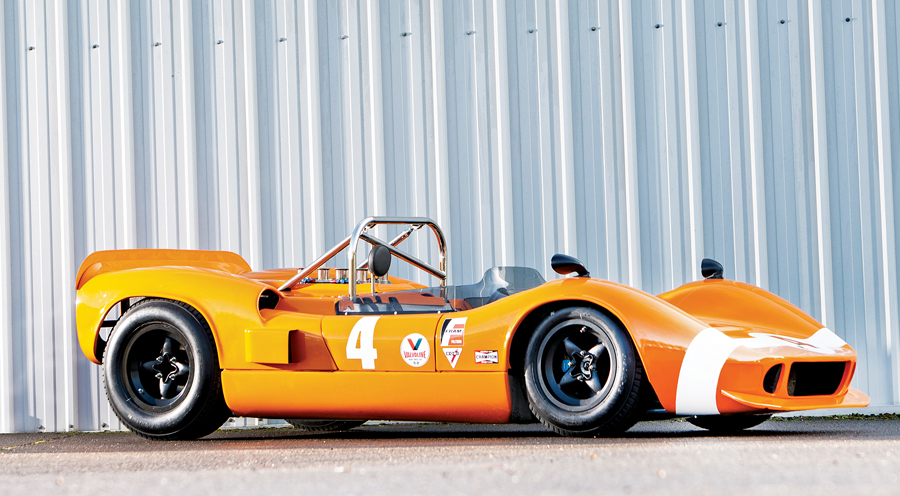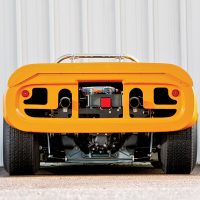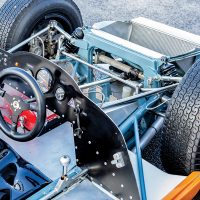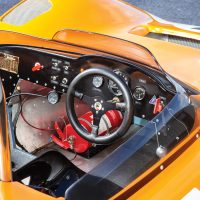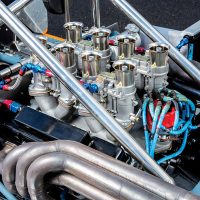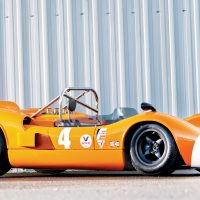SCM Analysis
Detailing
| Vehicle: | 1966 McLaren M1B Group 7 Can-Am Racer |
| Years Produced: | 1966 |
| Number Produced: | 28 |
| Original List Price: | $25,000 |
| SCM Valuation: | $225,000 |
| Chassis Number Location: | Plate in cockpit |
| Engine Number Location: | Right side above water pump |
| Club Info: | Elva Register |
| Website: | http://www.elva.com |
| Alternatives: | 1966 Lola T70 Mk 2, 1966 Chaparral 2E, 1965–66 Elva Mk 8 |
| Investment Grade: | B |
This car, Lot 85, sold for $225,476, including buyer’s premium, at Bonhams’ Goodwood Members’ Meeting auction on April 7, 2019.
The McLaren M1B has long held a very special place in my racing-car world. We had a sister car (8003) as an active and beloved component of the stable for over 25 years before sending it on to a younger enthusiast to continue its career.
The car was joyous to drive and just a little bit evil.
It was the last of the tube-frame, treaded-tire racers, and it heralded the transition to the insanely fast Can-Am racers that followed. It was both state of the art and quickly made obsolete, an icon for a season or two.
A new wave in race cars
Evolution and innovation come in waves, periods of relative stability interrupted by periods of rapid change. This certainly applies to racing-car design.
The 1950s were a decade of incremental improvements to well-established concepts and the gestation of some new ones. But everything exploded during the 1960s.
Mid-engine design became ubiquitous, tire technology grew exponentially and aerodynamic concerns changed from minimizing drag to trying to keep the cars from flying.
In 1963 the Elva Mk 7 was introduced, and it moved to modern 13-inch wheels. Like most of its contemporaries, it was designed to run in the small-bore classes, using a 100-hp, 200-pound Coventry Climax engine, 70-Series tires, and very soft spring rates.
The Elva 7 was an absolute dream to drive at the limit: comfortable and predictable.
But times were changing fast.
Fast times
Lotus took to using a 150-hp, 250-pound Ford Twin-Cam engine, so Elva followed. Tires evolved to 60 Series with more stick.
Then BMW 2-liter engines arrived with close to 200 horsepower, and running at the front required using them. The Elva 7 adapted and became much quicker, but the cars became less friendly — more like riding a tiger. It’s great fun, but don’t let your attention wander — they’ll bite.
Elva followed by introducing the Mk 8, designed specifically for the 2-liter BMW, but by then the V8-engine era had begun.
Racers took to dropping the 3.5-liter Oldsmobile 215 engine into the chassis with the same result — much faster, but spooky to drive.
At about the same time, Bruce McLaren and his team designed their M1 specifically to take that same 350-pound, 320-hp engine with the ever-wider tires that became available. Elva agreed to build the customer version of the car, called the Elva McLaren M1.
Enter the M1B
For 1966 the FIA introduced a new set of rules, called Group 7.
In response, McLaren and Elva updated the M1 to create the M1B.
The wheelbase remained the same, but the bodywork became more compact and the frame was substantially stiffer. And, of course, there was more tire.
The Chevrolet small-block V8 weighed 200 pounds more than the Oldsmobile, but at 5-plus liters, it generated loads more horsepower.
So 500-horsepower small blocks became the standard — no matter what the chassis.
The M1B was a ton faster than the M1, but it was a real challenge to drive at the edge.
Even in its glory year of 1966, the M1B struggled to match Lola’s T70, and 1967 saw the introduction of the McLaren M6, a longer-wheelbase monocoque design suitable to the new realities.
The M6 and subsequent M8 McLarens got everything right and were the basis for McLaren’s domination of Can-Am for years.
Perfect for the Goodwood Revival
The problem from a weapons standpoint is that as an early car, our subject will always be a backmarker in any Group 7 or Can-Am grid, and if you’re not a pretty competitive driver, you’re not playing in this group.
The result is that M1Bs have always been at the bottom of the Group 7 value range. They have been stuck between $225,000 and $250,000.
There is, however, one great, high-profile event that is perfect for these cars.
The Goodwood Revival has a very popular grid where M1Bs — along with Lola T70s — are the perfect weapons, as nothing newer is allowed.
If you want to play at Goodwood — and just have fun elsewhere — buying this car is a simple calculation.
Assuming you don’t break it — or yourself — ownership can be quite cost effective. You can always resell the car for the same price that you bought it, so all you have to pay for is the cost of racing.
That is a rational approach to a weapons-grade purchase. This car was fairly bought and sold. ♦
(Introductory description courtesy of Bonhams.)
